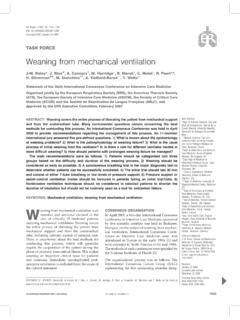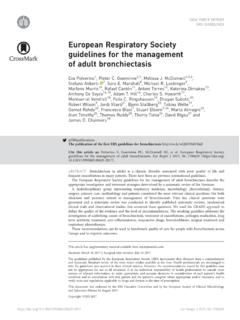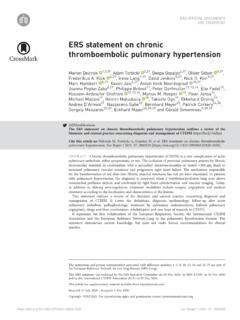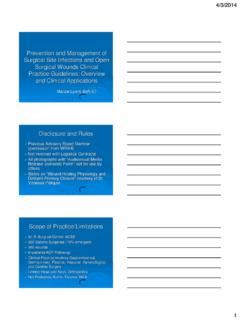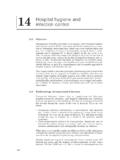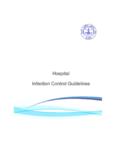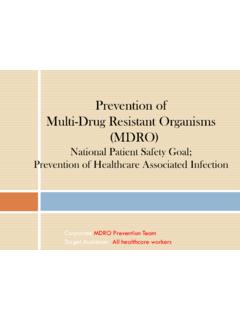Transcription of International ERS/ESICM/ESCMID/ALAT guidelines …
1 TASK FORCE REPORT. ERS/ESICM/ESCMID/ALAT guidelines . International ERS/ESICM/ESCMID/ALAT . guidelines for the management of hospital - acquired pneumonia and ventilator - associated pneumonia guidelines for the management of hospital - acquired pneumonia (HAP)/. ventilator - associated pneumonia (VAP) of the European Respiratory Society (ERS), European Society of Intensive Care Medicine (ESICM), European Society of Clinical Microbiology and Infectious Diseases (ESCMID) and Asociaci n Latinoamericana del T rax (ALAT). Antoni Torres1,16, Michael S.
2 Niederman2,16, Jean Chastre3, Santiago Ewig4, Patricia Fernandez-Vandellos5, Hakan Hanberger6, Marin Kollef7, Gianluigi Li Bassi1, Carlos M. Luna8, Ignacio Martin-Loeches9, J. Artur Paiva10, Robert C. Read11, David Rigau12, Jean Fran ois Timsit13, Tobias Welte14 and Richard Wunderink15. @ERSpublications ERS/ESICM/ESCMID/ALAT evidence-based recommendations for HAP/VAP diagnosis, treatment and prevention Cite this article as: Torres A, Niederman MS, Chastre J, et al. International ERS/ESICM/ESCMID/ALAT . guidelines for the management of hospital - acquired pneumonia and ventilator - associated pneumonia .
3 Eur Respir J 2017; 50: 1700582 [ ]. ABSTRACT The most recent European guidelines and task force reports on hospital - acquired pneumonia (HAP) and ventilator - associated pneumonia (VAP) were published almost 10 years ago. Since then, further randomised clinical trials of HAP and VAP have been conducted and new information has become available. Studies of epidemiology, diagnosis, empiric treatment, response to treatment, new antibiotics or new forms of antibiotic administration and disease prevention have changed old paradigms.
4 In addition, important differences between approaches in Europe and the USA have become apparent. The European Respiratory Society launched a project to develop new International guidelines for HAP. and VAP. Other European societies, including the European Society of Intensive Care Medicine and the European Society of Clinical Microbiology and Infectious Diseases, were invited to participate and appointed their representatives. The Latin American Thoracic Association was also invited. A total of 15 experts and two methodologists made up the panel.
5 Three experts from the USA were also invited (Michael S. Niederman, Marin Kollef and Richard Wunderink). Applying the GRADE (Grading of Recommendations, Assessment, Development and Evaluation). methodology, the panel selected seven PICO ( population intervention comparison outcome) questions that generated a series of recommendations for HAP/VAP diagnosis, treatment and prevention. This article has supplementary material available from Received: March 20 2017 | Accepted after revision: June 13 2017. This document was endorsed by the ERS Executive Committee, ESCMID and ALAT in July 2017, and by ESICM in August 2017.
6 Conflict of interest: D. Rigau acts as a methodologist for the European Respiratory Society. All other disclosures can be found alongside this article at Copyright ERS 2017. Eur Respir J 2017; 50: 1700582. ERS/ESICM/ESCMID/ALAT guidelines | A. TORRES ET AL. Affiliations: 1 Dept of Pulmonology, hospital Cl nic de Barcelona, Universitat de Barcelona and IDIBAPS, CIBERES, Barcelona, Spain. 2 Division of Pulmonary and Critical Care Medicine, Weill Cornell Medicine, New York, NY, USA. 3R animation M dicale, Groupe Hospitalier Piti -Salp tri re, Paris, France.
7 4 CAPNETZ. Stiftung and Thorax Centre in the Ruhr Area, Dept of Respiratory Medicine and Infectious Diseases, Evangelic hospital in Herne and Augusta hospital in Bochum, Bochum, Germany. 5 IDIBAPS, CIBERES, Barcelona, Spain. 6 Dept of Clinical and Experimental Medicine, Faculty of Medicine and Health Sciences, Link ping University, Link ping, Sweden. 7 Pulmonary and Critical Care Division, Washington University School of Medicine, St Louis, MO, USA. 8 hospital de Cl nicas Jos de San Martin , Universidad de Buenos Aires, Ciudad de Buenos Aires, Argentina.
8 9 Dept of Clinical Medicine, Wellcome Trust HRB Clinical Research Facility, St James's hospital , Trinity College, Dublin, Ireland and CIBERES, Barcelona, Spain. 10 Emergency and Intensive Care Dept, Centro Hospitalar S o Jo o EPE and Dept of Medicine, University of Porto Medical School, Porto, Portugal. 11 Academic Unit of Clinical Experimental Sciences and NIHR Southampton Biomedical Research Unit, Faculty of Medicine, and Institute for Life Sciences, University of Southampton, Southampton, UK. 12 Iberoamerican Cochrane Centre, Barcelona, Spain.
9 13 IAME, INSERM UMR 1137, Medical and Infectious Diseases Intensive Care Unit, Paris Diderot University and Bichat hospital , Paris, France. 14. Dept of Respiratory Medicine, Medizinische Hoschschule Hannover, Hannover and German Centre of Lung Research (DZL), Germany. 15 Division of Pulmonary and Critical Care Medicine, Northwestern University Feinberg School of Medicine, Chicago, IL, USA. 16 These two authors contributed equally to this work. Correspondence: Antoni Torres, Servei de Pneumologia, hospital Clinic de Barcelona, Villarroel 170, 08036.
10 Barcelona, Spain. E-mail: Introduction hospital - acquired pneumonia (HAP) is an infection of the pulmonary parenchyma caused by pathogens that are present in hospital settings [1]. Nosocomial pneumonia develops in patients admitted to the hospital for >48 h and usually the incubation period is at least 2 days. Among nosocomial pneumonias, ventilator - associated pneumonia (VAP) develops in intensive care unit (ICU) patients who have been mechanically ventilated for at least 48 h. Patients with severe nosocomial pneumonia who require mechanical ventilation during their treatment after the onset of infection do not meet the definition of VAP.

